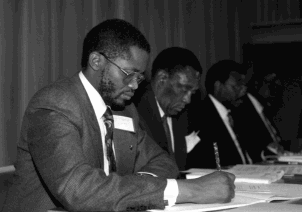This resource is hosted by the Nelson Mandela Foundation, but was compiled and authored by Padraig O’Malley. It is the product of almost two decades of research and includes analyses, chronologies, historical documents, and interviews from the apartheid and post-apartheid eras.
Overview of 1992
Although it might seem that in the period from 1990 to 1994 each year was more turbulent than the previous, in retrospect 1992 was undoubtedly the most tumultuous & the only one that staggered the process & brought it to its knees. But there was no knock out punch. Contradictions riddled the negotiations process. Since Mandela's release they cowed under the delicate veneer of goodwill. But with the relentless toll of violence, they slowly edged their way to the surface. Simmering differences only needed a single incident to ignite a tinderbox of grievances.
The year got off to a good start. On 8th January 1992 the ANC celebrated its 80th anniversary, the CODESA working groups got down to work intent on making their May deadline. The media began to talk about an interim government, even elections.
In February 1992 the NP did an about turn & accepted the ANC's demand for an interim government and that a new South Africa should be non-racial, non-sexist, and democratic. Working Group 2 produced an initial agreement on general constitutional principles: a multi party democracy, bicameral parliament, Bill of Rights, division of powers between branches of government, an independent judiciary, strong basis for regional government, proportional representation, the maintenance of language & cultural rights.
The process always faced the risks that the principals -- De Klerk & Mandela -- might run ahead of their constituencies & that they might, therefore, have to pause, reach back, ameliorate the fears of their constituents & lead them into the negotiating fold. De Klerk was the first to have to face threats to his position that emanated from within the white constituency. On 19th February a by-election was held in Potchefsroom, a hitherto rock solid safe NP stronghold, the home of De Klerk's university. As National Party as you can get. However, the Conservative Party won handily & it was no longer clear that de Klerk could claim to be negotiating on behalf of the majority of whites or that he could continue to claim that he had a mandate. He reacted decisively, calling a snap referendum for 17th March 1992.
Much as the ANC abhorred one more all white election it swallowed its objections, recognizing that it had to have a negotiating partner who could make a fair claim to being able to speak for the people he represented. The CP muddied the waters. Hence the matter had to be settled. De Klerk could no longer afford to negotiate looking over his shoulder at the CP, relentlessly criticizing but never offering an alternative, chipping away at his support base.
He shrewdly outmanoeuvred the CP. With a majority in the all white parliament the NP was able to choose the wording for the referendum question. It made it simple: "Do you support the continuation of the reform process that the state president started on 2 February 1990 and which is aimed at a new constitution through negotiations?" The wording allowed De Klerk to sidestep the worry on the minds of whites, which was being exploited by the CP: Were negotiations going to end up with a simple majority governing i.e. the ANC in charge of everything & whites marginalized. The referendum framed the question in a different context. It effectively said: a vote against the referendum question is a vote against negotiations & thus a vote for renewed violence & chaos. Faced with the Hobbsian choice whites voted overwhelmingly for De Klerk & gave him the mandate he sought 69 per cent voted 'yes.' It was the high point of de Klerk's presidency, a triumph of tactical politics.
The pace of negotiations quickened & agreement was reached in four of the five working groups on the issues they had been mandated to deal with. Agreed: The interim government would take place in two stages the first consisting of the formation of a Transitional Executive Council (TEC) and the second stage to commence after the elections made up of the interim government and constituent assembly. This Council would be multi-party in form functioning alongside the existing tricameral parliament. Key areas of government would have multi-party sub-committees of the TEC, the TBVC states should be reincorporated into South Africa but that the will of these states be tested in the coming elections.
Even in Group 4 substantial agreement was reached on matters that were subsequently incorporated into the interim constitution: a Transitional National Assembly, elected on proportional representation with half of the members elected from national party lists, and half from regional lists, a Parliament consisting of two houses compromising a National assembly & a Senate which would be bound by the constitutional principles agreed at CODESA, a multiparty transitional government & a final constitution, which would be written & adopted by the National Assembly acting as a Constitutional Assembly.
Indeed, when the plenary convened on 15 May the mood was both cautiously optimistic & apprehensive. While agreement had been reached in four of the working groups on matters they were mandated to deal with & on most matters in Group 4, one pivotal issue remained outstanding, eluding the best efforts to reach consensus. The matter outstanding was the percentage threshold for reaching agreement in a Constituent Assembly for adoption of a Bill of Rights & finalization of the Constitution. After some "all nighters," poker like stand-offs & a frenetic finale in which proposal & counter proposal were traded while the plenary waited for the outcome the government & the ANC failed to find a mutually acceptable compromise and had to inform the plenary that it could not do so. At issue was the question of somehow finding a middle path between what the ANC put on the table as its final offer: a two thirds majority for passing the constitution & bill of rights & the immediate institution of an interim government with executive powers. The NP's final offer was for 70 per cent for ratification of the final constitution & a three quarter majority for a bill of rights & the principles for the restructuring of government. The ANC countered with 70 per cent for ratification of the constitution & 75 per cent for a bill of rights. However, it added a rider: if the constitution was not completed within a stipulated time period, then the draft constitution would be put to the people in which case 50 per cent plus one would become the deadlock breaking mechanism. This was a calculated gamble on the part of Cyril Ramaphosa, the ANC's chief negotiator, since the NEC had not authorized his proposal. And the gamble worked. The NP refused the bait. Thus, failure to reach agreement could be put on the government & the ANC could claim that matters broke down because the NP wanted a veto power over the process.
This deadlock ensured no final agreement. The ANC's fear was that if it accepted the NP proposal it could find itself endlessly trapped in an interim government, if it and it's allies did not receive more than 70 per cent of the vote and some polls showed that the NP might take 30 per cent of the black vote. The NP's fear was that the ANC would simply veto any draft constitution until the stipulated time limit was reached & then put a final constitution of its own liking that would only require a simple majority for ratification from the electorate.
CODESA II ratified no agreements. However, the Management Committee was authorized to schedule another plenary at which the agreements reached in Groups other than Group 4 would be ratified. Agreements dealing with free political activity, the future of the SABC & political intimidation would be implemented immediately. Despite the breakdown, parties left CODESA with a sense of real achievement & with lessons learned. The meeting was adjourned but not before it authorized the Management Committee to establish a structure to resolve the outstanding issue in Working Group 4.
In "Soul of the Nation," Hassen Ebrahim's monumental documentation of the constitution-making process in South Africa, he writes that": "There is nothing like a crisis to focus the minds of negotiators on the crucial issues at hand." The homeland parties & parties in the Tricameral parliament had to decide who to align themselves with ANC, NP or Inkatha. It made clear what the NP's bottom line would be: a guaranteed role in government post elections the enshrinement of compulsory power sharing in the final constitution. And it also made clear the key thrust of the NP's strategy: insist on having as much of the interim constitution as possible incorporated verbatim in the final constitution. The ANC's strategy was just the opposite.
After CODESA 11 deadlocked there was much finger pointing & speculation that the ANC had deliberately engineered the deadlock indeed, Cyril Ramaphosa admitted as much. Some analysts say that ANC negotiators were way ahead of the grass roots, which felt left out of the process the mood on the ground was a lot more militant than in Kempton Park where CODESA met.
Whatever, such speculation etc became irrelevant with the Boipatong massacre on 17th June when at least 40 people were shot or hacked to death in a midnight attack on shacks at the Boipatong squatter camp 50 kms south of Johannesburg. Inkatha supporting residents of the nearby KwaMadala hostel had carried out the massacre. In the bedlam that followed there were reports that police trucks either carried or accompanied the hostel dwellers to the scene. There were reports of police collusion, even participation, in the massacre. President de Klerk tried to visit the township but was driven out by angry crowds. In the fracas that followed, police opened fire on the crowd and another nine people were killed.
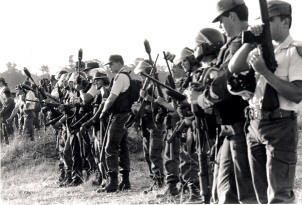
And when Mandela went to Boipatong the crowd in the stadium greeted him in song: "We are the lambs & you are leading us to slaughter."

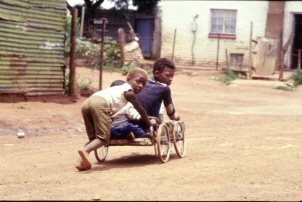
For Mandela that was it. He broke off talks with the government. The NEC held an emergency meeting about the massacre; made 14 demands and accused the government of complicity in the violence. The unions embarked on mass action. On the 15th and 16th July the Alliance committed itself to a month of rolling mass action to support its demands. The ANC used Boipatong to demonise de Klerk in the townships to the point of almost accusing him of personally ordering the massacre. Whatever support he had in the townships was emasculated. Never again would he be referred to as Comrade de Klerk. Mandela & de Klerk exchanged long memoranda. Each exchange between the two seemed to make things worse.
On 2nd August 1992 the United Nations Security Council held a special session to debate the violence in South Africa. All parties trooped to New York to enlist the world on their side. The UN adopted special resolution No. 765 appointing Cyrus Vance, as the Secretary General's representative to visit South Africa. A Monitoring Committee arrived in South Africa shortly afterwards & met with all the parties & representatives of civil society. They left, and that was the end of UN involvement in SA's negotiations.
The alliance turned to mass action once again. A two day general strike in support of negotiations drew 4 million workers, the largest ever stayaway in SA's history. Over 100,000 marchers converged on the Union Buildings in Pretoria where Mandela addressed them. The rhetoric was tough. This time they were outside; next time they'd be inside.
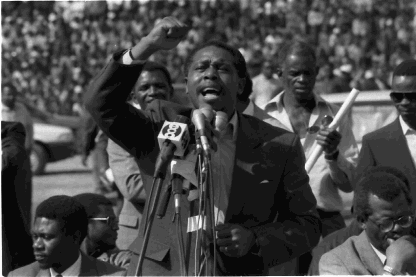
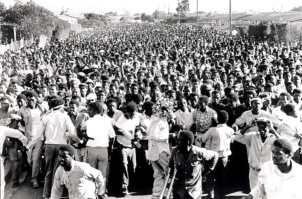
But despite the breakdown the government & the ANC continued to have clandestine meetings, first between Roelf Myer for the government & Cyril Ramaphosa for the ANC. Later they included others. The "channel," as it came to be called, worked assiduously to resolve differences. Between June & September Meyer & Ramaphosa met at on 43 occasions. Between them they opened the road to peace. Their engagement led them to develop a relationship of trust, a key ingredient of a successful negotiating process. Meyer was a dove. From the beginning he knew that majority rule was inevitable. Not that he negotiated from that perspective. His perspective had to take account of what de Klerk could in the final analysis sell to his Cabinet, his party, his constituency, the security forces & forestall a white right wing backlash.
With meetings going on unknownst to all but the participants & the mood getting more ugly in the townships, the NEC adopted a more militant strategy towards the Independent states a policy of rolling mass action to topple them, a variant of the "Leipzig" option when the sheer numbers of East Germans marching together in 1989 demanding an end to communist party rule brought the government down. Of the four states, the Ciskei government of Oupa Gqoso was the most vulnerable. On 7 September 70,000 demonstrators, including Ramaphosa, marched from King Williamstown to the outskirts of Bisho, 3- 4 kms away.

Permission had been received from a Ciskein magistrate to hold a demonstration, but with the stipulation that it could not go further than the Bisho independence stadium. However, Ronnie Kasrils and many others broke away and ran across the stadium. Soldiers in the Ciskei Defence Force opened fire & 28 demonstrators were killed, 200 wounded.
The second massacre within six months served notice: unless the ANC & the government began to row together, things could easily fall apart. Moreover, Derek Keys, a businessman who had been appointed Minister of Finance with the backing of the ANC, warned both Mandela & de Klerk that South Africa was stony broke, that unless they reached an accommodation there might not be much of South Africa to inherit or to fight over.
Alignments shifted. The NP dropped the idea of wooing Inkatha. It realized that it would have to do business with the ANC & that only the NP and ANC working in concert could establish the political climate in which a constitutional settlement would be forged. The ANC dropped the idea that it alone could rule successfully in a post apartheid South Africa, that the NP was not a defeated enemy; that in the end compromise was the essence of negotiations.
Thus, on 26 September the ANC & the NP signed a Record of Understanding, the turning corner on the road back to the negotiations table. But the breakthrough revealed the schism within the NP. On the one side the hardliners led, ironically, by Justice Minister Kobie Coetsee, who believed that the government should adopt a more aggressive negotiations posture, on the other side the 'realists,' led by Roelf Meyer who wanted to get on with the job.
The Record of Understanding addressed the major areas of deadlock & laid the basis for the resumption of multi party talks.
In October, Parliament approved changes to the Constitution so that the president could appoint ministers and deputy ministers from outside Parliament & the National Council on Indemnity was set up to indemnify people who had committed politically motivated crimes.
In November the NEC adopted a paper called "Strategic Perspectives." Slovo argued that the ANC's objective of majority rule could be achieved in phases. He identified five: the establishment of a transitional executive council, the election of a constituent assembly, the establishment of an interim government of national unity, the drafting of a new constitution and the period for the consolidation of the new democracy. In order to provide stability during the transition to full democracy, the security forces & civil service had to be kept "on side." By including provisions for the guarantee of job security & retrenchment packages for civil servants in the final settlement issues relating to stability during transition would be addressed. These clauses were referred to as the "sunset clauses."
The Record of Understanding left Buthelezi flatfooted, with no partner to dance with. The provision in the Record of Understanding providing for the fencing of hostels & restrictions on the carrying of "cultural weapons" infuriated him. He felt betrayed by de Klerk. He lurched further to the right forming along with Bophuthatswana's Lucas Mangope, Ciskei's Oupa Gqozo, the CP, its breakaway group, the Afrikaner Volksunie (AVF) and the Afrikaner Freedom Foundation the Concerned South Africans Group (COSAG) -- the first formal alliance in South Africa between black & white right wing African organizations. COSAG demanded that the Record of Understanding should be scrapped. In December the KwaZulu legislature approved a draft constitution that envisaged a form of federal autonomy. Seeing himself being dealt out of the high stakes negotiations line up Buthelezi upped the ante & put his secession card into play.
